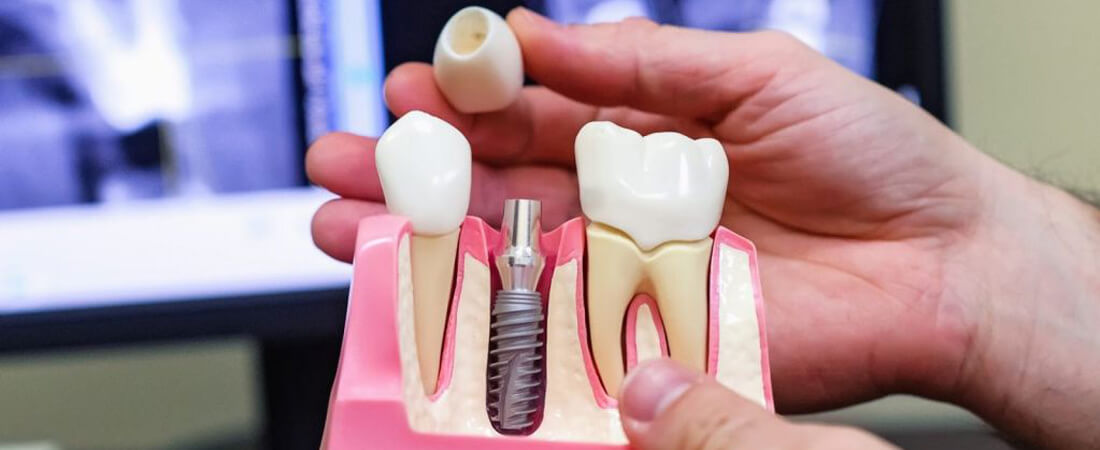Dental Implantation
Dental implant placement is a surgical procedure in which the roots of teeth are replaced with metal screw-shaped implants that support artificial crowns.
Implant placement surgery in Yerevan, Armenia, serves as an alternative to bridge structures or removable dentures.
Successful dental implantation is generally defined as a 95% engraftment rate sustained over five years.
Dental implants are surgically inserted into edentulous (toothless) areas, where they act as artificial roots for missing teeth. Made of titanium and coated with a specialized surface, implants integrate with the bone over time.
Conditions and Indications for Dental Implantation in Yerevan, Armenia:
- Missing teeth
- A fully developed jawbone
- Sufficient bone tissue for fixation, or the feasibility of bone grafting
- Absence of oral mucosal pathology
- No systemic diseases that impair tissue regeneration
- An aversion to removable dentures
- Desire to improve speech articulation
- Willingness to commit to a long treatment process
As with any medical intervention, dental implantation carries potential complications and contraindications. However, complications are generally rare, mild, and easily treatable.
The success of dental implantation depends on both patient-related and procedural factors. Several etiological factors—biological, mechanical, or iatrogenic—can affect osseointegration in both early and long-term stages.
Patient-related factors: bone volume and quality, smoking, diabetes, hypertension.
Implant-related factors: implant design, diameter, length, and crown characteristics.
According to the International Congress of Oral Implantologists (ICOI) consensus in Pisa, unsuccessful implantation is defined as implant mobility, pain under functional loading, or bone loss exceeding 50% of the implant’s length.
Albrektsson et al. state that the implant is considered successful in the absence of mobility, infection, and discomfort, with bone loss remaining under 0.2 mm per year after the first year under load.
Possible Complications:
- Infection
- Damage to surrounding structures, such as teeth or blood vessels
- Nerve injury, leading to numbness, tingling, or pain in the gums, chin, lips, or teeth
- Maxillary sinus complications in upper jaw implant placement
- Titanium allergy (very rare, affecting 0.6–5% of cases), manifesting in skin, mucosal, or systemic reactions
Allergy Diagnostics:
- Epicutaneous or intradermal tests
- Blood tests (e.g., LTT, MELISA, IL1β, IL-6, TNF-α, IL-10)
- Zirconia implants are an alternative for those allergic to titanium.
Bone Quality Considerations:
Bone quality and volume significantly influence outcomes. Type 3 or 4 bone (lower quality) may compromise osseointegration.
Research by Wang shows that 90% of implant failures occur at the initial stages of integration. Also, smaller and shorter implants, especially in smokers, carry a higher risk of failure.
Team Involvement:
A multidisciplinary team—maxillofacial surgeon, oral surgeon, dentist, periodontist, prosthodontist, and sometimes ENT specialist—is involved in planning.
Preparation Includes:
- Full dental examination and 3D CT imaging
- Review of medical history and current medications
- Pain management options: local anesthesia, sedation, or general anesthesia
Dental implantation in Yerevan, Armenia, is typically outpatient and multi-staged, involving:
- Jawbone preparation
- Implant placement
- Osseointegration and healing
- Abutment and crown installation
Total treatment may span several months, although some steps can be combined depending on the case.
Postoperative Recommendations:
- Remain at the clinic for observation
- Arrange transportation home; avoid driving
- Avoid hot/spicy foods, smoking, alcohol, saunas, pools, gyms, and stress
- Maintain excellent oral hygiene
Bone Grafting:
If the jawbone lacks sufficient density or volume, bone grafting may be required. Grafts may be autogenous (your own bone) or synthetic. Healing takes several months. Minor grafting can sometimes be done at the time of implant placement.
Implant Placement Procedure:
A gum incision exposes the bone, holes are drilled, and the implant is inserted. Osseointegration takes 3–6 months.
Abutment Placement:
After osseointegration, a minor outpatient procedure is done under local anesthesia to place the abutment. Healing takes around two weeks.
Postoperative Symptoms:
- Swelling of the gums or face
- Pain at the implant site
- Minor bleeding
Advanced Techniques:
Zygomatic Implants: Used when upper jawbone is extremely atrophied. They anchor into the zygomatic (cheek) bone and offer a one-step alternative to complex grafting procedures. Four cortical bone layers ensure high success rates (95–100%).
Indications:
- Severe resorption
- Autoimmune diseases
- Post-radiation damage
- Congenital anomalies
- Maxillary resection
Contraindications:
- Smoking
- Head/neck radiotherapy
- Bisphosphonate therapy
- Respiratory infections
Transposition of the Inferior Alveolar Nerve:
For patients with extreme lower jaw atrophy, this technique repositions the nerve to enable implant placement. It carries risks like lip numbness or jaw fracture but can be effective in experienced hands.
Pterygoid Implants:
These implants are placed into the pterygoid process of the sphenoid bone as an alternative to sinus lifting. Success depends on precise imaging and planning. Advantages include minimal invasiveness, stability, and reduced need for posterior prosthetic extensions.
Challenges:
- Proximity to vital structures
- Vertical space limitations
- Implant tilting requiring angled abutments
- Possible crown/screw failures due to strong bite forces
Simultaneous Tooth Extraction and Implantation:
This method has a success rate of 92–98% over 15 years. Some studies (e.g., by Kim and Susarla) show that placing an implant immediately after extraction under direct load may reduce osseointegration and increase bone resorption. Specifically, they found a 2.7 times higher likelihood of compromised integration in such cases.
Nonetheless, other authors (Polizzi, Covani) report no significant difference in success between immediate and delayed implantation.
Prices
There is no fixed price list of operations on the Website, as the cost of aesthetic surgery can vary depending on many factors.:
- Type of surgical operation
- The volume and duration of operations
- Materials used
- Type of anesthesia
- The initial state of the operated area
- The complexity of the operation being performed
The patient’s nationality does not affect the cost of operations. We practice an individual approach. The price of the operation is determined by direct examination of the patient or by examining photographs.
You can send photos by email:


